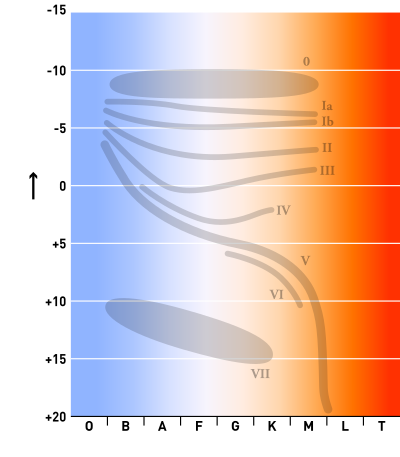
Back Reusester Afrikaans نجم عملاق Arabic Estrella xigante AST Зорка-гігант Byelorussian Гигант (звезда) Bulgarian দৈত্য তারা Bengali/Bangla Divovska zvijezda BS Estrella gegant Catalan ئەستێرەی زەبەلاح CKB Obr (hvězda) Czech
A giant star has a substantially larger radius and luminosity than a main-sequence (or dwarf) star of the same surface temperature.[1] They lie above the main sequence (luminosity class V in the Yerkes spectral classification) on the Hertzsprung–Russell diagram and correspond to luminosity classes II and III.[2] The terms giant and dwarf were coined for stars of quite different luminosity despite similar temperature or spectral type (namely K and M) by Ejnar Hertzsprung in 1905[3] or 1906.[4]
Giant stars have radii up to a few hundred times the Sun and luminosities between 10 and a few thousand times that of the Sun. Stars still more luminous than giants are referred to as supergiants and hypergiants.
A hot, luminous main-sequence star may also be referred to as a giant, but any main-sequence star is properly called a dwarf, regardless of how large and luminous it is.[5]
- ^ Patrick Moore, ed. (2002). "Giant star". Astronomy Encyclopedia. New York: Oxford University Press. ISBN 0-19-521833-7.
- ^ John Daintith and William Gould, ed. (2006). giant (5th ed.). New York: Facts On File, Inc. ISBN 0-8160-5998-5.
- ^ Russell, Henry Norris (1914). "Relations Between the Spectra and Other Characteristics of the Stars". Popular Astronomy. 22: 275–294. Bibcode:1914PA.....22..275R.
- ^ Brown, Laurie M.; Pais, Abraham; Pippard, A.B., eds. (1995). Twentieth Century Physics. Bristol, UK; New York, NY: Institute of Physics, American Institute of Physics. p. 1696. ISBN 0-7503-0310-7. OCLC 33102501.
- ^ Jacqueline Mitton, ed. (2001). Giant star. Cambridge: Cambridge University Press. ISBN 0-521-80045-5.
© MMXXIII Rich X Search. We shall prevail. All rights reserved. Rich X Search
